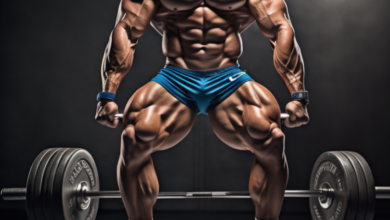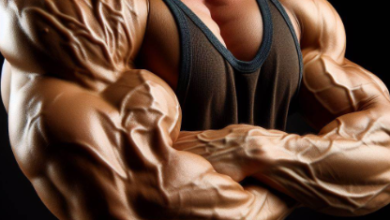Power building – When Bodybuilding & Powerlifting Collide!
Introduction
In the dynamic realm of fitness, there exists a hybrid training approach that seamlessly fuses the hypertrophy-centric world of bodybuilding with the strength-focused domain of powerlifting. This fusion, aptly named “Power building,” has gained substantial recognition among fitness enthusiasts for its ability to deliver a unique blend of muscle growth and raw strength. In this comprehensive exploration, we delve into the intricacies of Power building, unraveling its principles, benefits, key differences from traditional bodybuilding and powerlifting, and how to embark on a transformative Power building journey.
Understanding Powerbuilding
Definition and Origins

Power building is a training philosophy that marries the principles of bodybuilding and powerlifting. Bodybuilding emphasizes sculpting and developing muscle mass, focusing on aesthetics, symmetry, and proportion. Powerlifting, on the other hand, is centered around mastering three primary lifts – squat, bench press, and deadlift – with the goal of achieving maximum strength.
The Fusion: Strength and Aesthetics

Power building harmoniously integrates these two seemingly disparate worlds. It aims to build not only impressive muscle size but also formidable strength. The result is a physique that possesses both the sculpted aesthetics of a bodybuilder and the raw power of a powerlifter.
Key Principles of Power building
1. Progressive Overload

Central to Power building is the principle of progressive overload. This involves consistently challenging your muscles by gradually increasing the resistance or weight lifted. Whether you’re aiming for a new one-rep max in the squat or pushing for more reps in your bicep curls, the goal is continual progression.
2. Compound Movements

Power building emphasizes compound movements that engage multiple muscle groups simultaneously. Squats, deadlifts, bench presses, and overhead presses take center stage, fostering comprehensive muscle activation and functional strength development.
Strong and shapely glutes not only contribute to a well-balanced physique but also play a crucial role in overall lower body strength and stability. If you’re aiming to sculpt your buttocks and develop symmetrically strong legs, incorporating targeted exercises into your routine is key.
3. Hypertrophy Focus
While powerlifting focuses on strength, Power building places a significant emphasis on hypertrophy. Targeted isolation exercises and higher rep ranges are incorporated to stimulate muscle growth and create a more aesthetically pleasing physique.
4. Periodization

Structured periodization is integral to Power building. Training cycles alternate between periods of hypertrophy-focused workouts and strength-focused phases. This systematic approach prevents plateaus, optimizes recovery, and ensures continued progress.
The Benefits of Power building
1. Dual Progression

One of the primary benefits of Power building is the dual progression it offers. Practitioners witness gains in both strength and muscle size, leading to a well-rounded and robust physique.
2. Enhanced Athletic Performance

Power building enhances overall athletic performance by combining the agility and explosiveness associated with powerlifting with the endurance and muscle definition characteristic of bodybuilding. This versatility is particularly advantageous for athletes engaged in various sports.
3. Sustainable Long-Term Results

The balanced approach of Power building contributes to long-term sustainability. By avoiding the potential pitfalls of excessive specialization, such as overuse injuries in powerlifting or aesthetic imbalances in bodybuilding, practitioners are better positioned for consistent progress over the years.
Power building vs. Traditional Bodybuilding
1. Emphasis on Strength
While bodybuilding prioritizes muscle size and aesthetics, Power building distinguishes itself through a notable emphasis on strength development. The pursuit of one-rep maxes in compound lifts is a key feature that sets Power building apart.
2. Training Intensity
Power building often involves training at higher intensities, especially in compound lifts, to foster strength gains. Traditional bodybuilding, while still intense, typically involves higher rep ranges to induce hypertrophy.
3. Periodization Structure
The periodization structure in Power building incorporates distinct cycles for strength and hypertrophy, providing a balanced approach. Traditional bodybuilding may employ less structured periodization, with an ongoing focus on hypertrophy.
Power building vs. Traditional Powerlifting
1. Aesthetic Component
Power building introduces an aesthetic component that is less emphasized in traditional powerlifting. While powerlifters prioritize strength, Power builders seek to create a balanced physique that includes muscle definition and proportion.
2. Exercise Variation
Power building incorporates a broader range of exercises, including both compound and isolation movements. Traditional powerlifting places a more exclusive focus on the three primary lifts – squat, bench press, and deadlift.
3. Rep Ranges
Power building incorporates a variety of rep ranges to address both hypertrophy and strength. Traditional powerlifting often centers around lower rep ranges, emphasizing maximal strength development.
How to Start Power building
1. Assess Your Goals
Clearly define your fitness goals. Determine whether you prioritize strength, aesthetics, or a balanced combination of both. This initial assessment will guide your Power building journey.
2. Establish a Solid Foundation
Ensure proficiency in compound lifts. Mastering proper technique in squats, deadlifts, and bench presses is foundational for effective Power building.
3. Design a Periodized Program
Create a periodized program that includes distinct training cycles for hypertrophy and strength. Focus on progressive overload to drive continual improvement.
4. Include Compound and Isolation Movements
Incorporate a mix of compound and isolation movements. While compound lifts form the core, isolation exercises target specific muscle groups, promoting comprehensive development.
5. Prioritize Recovery
Prioritize recovery with sufficient rest days, quality sleep, and proper nutrition. Recovery is integral to realizing the benefits of Power building and preventing burnout.
6. Track and Adjust
Regularly track your progress. Adjust your training program based on results and align it with your evolving goals. Flexibility is key to a successful Power building journey.
Conclusion
Power building stands as a testament to the synergy achievable when bodybuilding and powerlifting collide. It offers a holistic approach to fitness, where the pursuit of strength and aesthetics coalesce to produce a physique that is not only visually impressive but also functionally robust. Whether you’re a seasoned lifter seeking a new challenge or a newcomer intrigued by the prospect of comprehensive growth, Power building opens the door to a transformative fitness journey.






